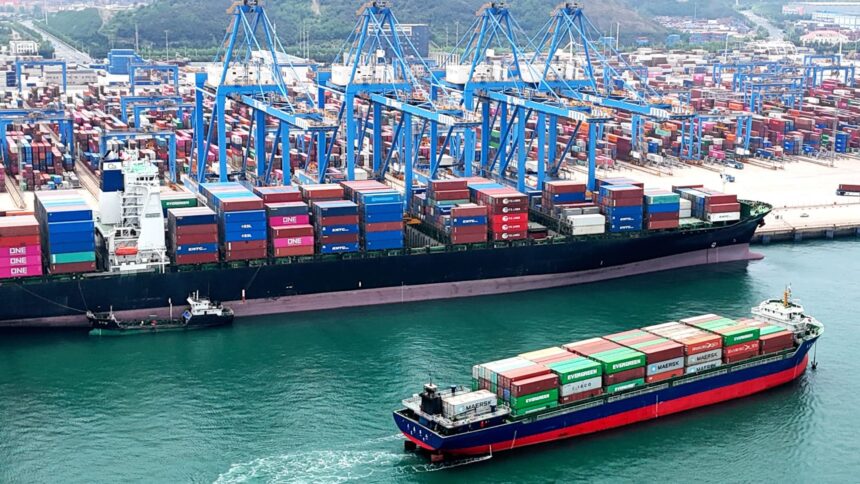A cargo ship is sailing to a foreign trade container port in Qingdao Port, Shandong province, in Qingdao, China, on June 7, 2024.
Costfoto | Nurphoto Getty Images
Trade analysts warned that the new tariffs threatened by former President Donald Trump, which he doubled down on during Tuesday night’s presidential debate, would put inflationary pressure on supply chains and ripple through the broader economy.
Trump defended his trade policy during the debate, dismissing concerns that blanket tariffs of up to 20% on all imports and additional tariffs of 60% to 100% on goods from China would lead to higher consumer prices.
Judah Levine, head of research for Freightos, said if history is any guide, additional tariffs will increase ocean freight rates. During the first Trump administration, when importers rushed to move goods to the country before tariffs took effect, sea container rates from Asia to the US West Coast began to rise sharply in July 2018, and doubled in mid-November, according to Freightos data.
Levine said the Biden administration’s announcement last May of planned tariff increases on certain Chinese goods, scheduled to take effect on August 1, also contributed to the front-loading of products. Biden’s tariff hike was delayed at the last minute by the US Trade Representative’s office pending a full review.
Those tariff risks, along with the Red Sea crisis and the potential for a dock workers’ strike in October, contributed to an early and strong peak shipping season this year, Levine said, with rates from Asia to the US West Coast nearly tripling from May to mid-July. – up to $8,000/unit of container equivalent to forty feet.
“If Trump wins the election, we will see an immediate increase in import volumes because importers will want to rush some cargo in anticipation of the new tariffs,” said Lars Jensen, CEO of Vespucci Maritime. “The new tariffs could come in at the end of January, so that leaves a very short window to get things imported before the tariffs.”
Any increase in cargo demand will fuel it, said Peter Sand, chief shipping analyst at ocean freight rate intelligence platform Xeneta.
“Shippers are reacting to supply chain threats by rushing to import goods as much as possible,” Sand said. “Frontloading of imports has contributed to a massive increase in freight rates after the outbreak of the conflict in the Red Sea and we will see the same behavior from shippers ahead of any new tariffs coming into force.”
“As the ocean container shipping market increases, these costs will decrease and ultimately the end consumer pays the price,” added Sand. “It could be through the increased cost of goods on the shelf or a limited choice in available products.”
Xeneta data shows the last time Trump raised tariffs on Chinese imports during the trade war in 2018, the ocean container shipping market grew by more than 70%. The average spot freight rate increased from $1,503 per FEU (40-foot container) on January 1, 2018 to $2,604 per FEU on November 1, 2018.

“Raising barriers to trade is almost always a negative move,” said Sand. “We saw the cost of shipping goods by sea rise dramatically when Trump introduced tariffs back in 2018 and the latest proposals will just be a case of history repeating itself.”
Trump refuted claims of higher consumer prices due to tariffs during the debate saying “We’re going to get billions of dollars, hundreds of billions of dollars. I have no inflation, almost no inflation, they have the highest inflation, maybe in the history of our country.”
Trump’s tariff proposal comes at a time when global maritime supply chains have been strained by conflicts in the Red Sea and the risk of port attacks.
Xeneta data shows spot rates in trade from the Far East to the US East Coast increased 303% between December 1, 2023 and July 1, 2024. Spot rates from the Far East to the US West increased 389% during the same period.
“Whether it’s a trade war or a conflict in the Red Sea, geo-political disruption is toxic to maritime supply chains and is occurring with higher frequency than ever before,” Sand said. “Shippers and freight forwarders don’t like uncertainty because it reduces their ability to manage supply chain risk. This is why people who work or operate in the maritime industry embrace global trade and don’t want to see tariffs or other barriers.”
The US-China trade war and multiple rounds of tariffs from the Biden and Trump administrations, with more threats to come, have also led to an increase in supply chains with a focus on Mexico. According to a report released by Moody’s on Wednesday, the proportion of China’s imports to the US has fallen sharply over the past two years, from almost 19% at the beginning of 2022 to only 13.5% at the end of 2023. Meanwhile, US imports from Mexico have increased by about 16% by the end of 2023, from 13.5% at the beginning of 2022, making Mexico the number 1 product in the US market. China, dropped to second place in trade with the US at the end of 2022, then replaced by Canada, which rose to number 2 in the last quarter of 2023.
Increased Asian nearshoring in Mexico is expected to be part of the next review date in the United States-Mexico-Canada Agreement (USMCA), with the outcome of the presidential election likely to influence the outcome. By July 1, 2026, the US, Mexico, and Canada will confirm in writing whether or not to continue the agreement, or if one or more of the three parties decide to take steps not to renew the agreement.
During Tuesday night’s debate, Trump renewed claims he’s made before about Mexican manufacturing being tied to China. “They’re building big car factories in Mexico, in many cases owned by China… They’re building these big factories, and they think they’re going to sell cars to the United States because of these people (Biden’s) administration. ),” Trump said.



